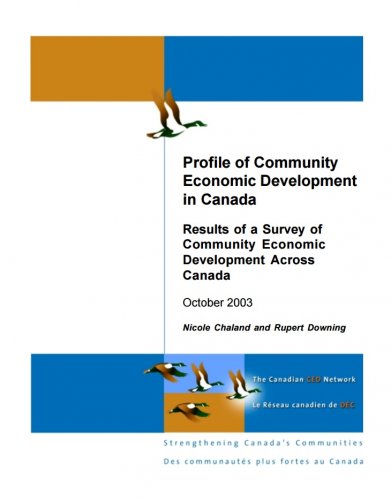This report is the result of a survey of 340 community economic development (CED) organizations undertaken by the Canadian Community Economic Development Network (CCEDNet). It represents a significant step in getting the sector ready for a new, higher level of activity. This research starts the process of identifying and organizing a body of CED experience and knowledge and assembles it in a form we all can make use of.
This profile reports on three principal themes: the nature, size, and lessons learned of the sector. The nature of CED establishes a typology for CED organizations, their distribution and maturity, enumerates their activities, and identifies proven practices and barriers to growth. The size of the sector is quantified in terms of employees and volunteers, as well as size of budget and revenue sources. Lessons learned about the sector are revealed through comments from CED organizations about proven practices and barriers hindering success of CED in their community.
Download the Profile of CED in Canada
The respondents were very diverse. They included small and large operations; were incorporated as public, private, and civil agencies; and were located in both rural and urban communities. Common to all respondents was an understanding of community economic development as local action and strategies creating economic opportunities and enhancing social conditions in an inclusive and sustainable manner.
The challenge has been to create a portrait of the sector while permitting people to make a reasonable comparison of particular details.
Outcomes of this research include a research database that can be used for additional research, a searchable online directory of CED organizations in Canada, and a report describing the CED sector in Canada.
Table of Contents
Executive Summary
1. Introduction
1.1. Community Economic Development in Canada
1.2. Research Objectives
1.3. Research Outcomes
1.4. Research Methodology
2. Nature of the CED Sector
2.1 Geographic Distribution
2.2. Urban Rural Distribution
2.3. Incorporation Type
2.4. Age of CED organizations
2.5. Activities of CED organizations
2.6. Type of Groups involved in CED
3. Size of the CED Sector
3.1. Staff and Volunteers of CED organizations
3.2. Revenue Size and Revenue Source
4. Barriers
4.1. National
1. Lack of government support
2. Lack of community capacity
3. Lack of leadership and collaboration
4. Barriers to citizen participation
5. Economic conditions
4.2 Regional Barriers to CED
1. Urban British Columbia
2. Rural British Columbia
3. Urban Prairies
4. Rural Prairies
5. Urban Ontario
6. Rural Ontario
7. Urban Quebec
8. Rural Quebec
9. Urban Atlantic
10. Rural Atlantic
11. The North
4.3. Need for a policy response
5. Best Practices
5.1. Human resources development
5.2. Providing access to capital
5.3. Public education and advocacy
5.4. Capacity building
5.5. Enterprise development
6. Lessons Learned
6.1. Human resources development
6.2. Providing access to capital
6.3. Public education and advocacy
6.4. Capacity building
6.5. Enterprise development
7. Conclusion
8. Reference List
Appendix A: The Survey





